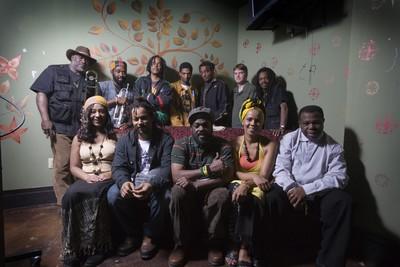Humble Beginnings

Growing up in Kingston, Jamaica, in the 1950s, you had to be inventive if you wanted to play a musical instrument.
Just as in most families then, times were hard in the seven-member Barrett household. There was no money to buy a bass guitar or drum kit for the two budding musicians in the family — Aston and his younger brother Carlton, or Family Man (Fams for short) and Carly as they were known to their friends.
So, they had to make do.
Fams made his own bass guitar out of plywood, a piece of curtain rod and a two-by-four. And Carly used paint can lids to make his drum kit. For a bass drum, he would tap his foot on the wood floor in the family home.
From those humble beginnings came reggae’s most acclaimed and influential rhythm section, based on their work with Bob Marley & The Wailers.
Marley died of cancer in 1981 and Carly was murdered in 1987, but Fams continues to keep the Wailers flame burning around the world, including a current tour that brings them to the Reggae in the Desert festival Saturday at the Clark County Government Center Amphitheater.
Also on the bill are Third World, Don Carlos, the Itals, FourTwentyDaze and Ras Indio.
Barrett is the bandleader of The Wailers, a group that still is made up of his own hand-picked musicians, including some of the original Wailers, such as American guitarist Al Anderson and keyboardist Keith Sterling.
With the exit of lead guitarist and lead vocalist Junior Marvin, Barrett picked a young Jamaican singer named Yvad to take on the daunting task of filling Marley’s shoes.
In a recent phone interview, Barrett, 60, talked about his beginnings in music.
“My dad was a great harmonica player,” Barrett says in his heavy Jamaican accent. “We used to listen to all type of music on the radio. We took in all that and came up with reggae.”
Barrett may have listened to everything, but judging from his style of playing, the blues was a major influence, as well as the funky R&B from James Brown’s band. He jammed the two together, slowed the tempo and added some judicious pauses to create a style that has influenced a lot of bass players, including Flea from Red Hot Chili Peppers.
“I love the blues for sure,” Barrett says, “and reggae got soul. I listen to anything that sounds good. … One good artist inspires another. You get inspired then improvise and take it to the next stage.”
Barrett and his brother Carly were one of the hottest session duos in Kingston, working with a host of now obscure singers on many hit songs, and top producers as well, such as Lee “Scratch” Perry. They became the backbone of Perry’s house band, called the Upsetters.
Meanwhile, Marley and his friends, vocalists Peter Tosh and Bunny Livingston, known as The Wailers, were turning out some hits of their own. Barrett remembers his reaction when he heard Marley’s first big hit, “Simmer Down.”
“I listened to that and fell into a trance,” Barrett says. He dreamed of working with the men who created that song. “As time go by it become a reality.”
Barrett met Marley several years later, in 1968, when Marley sent a friend out looking for a bass player. He brought back Family Man. Marley conferred with Tosh and Livingston and they agreed to bring him onboard.
They continued working with The Wailers until Marley’s death.
In 1972, The Wailers recorded their breakthrough album for the Island Records label, “Catch a Fire,” followed a year later by “Burnin’,” which contained “I Shot the Sheriff,” which became a hit for Eric Clapton.
In May 1973, Marley and The Wailers were the opening act for Sly & the Family Stone, causing jaws to drop in auditoriums around the country, first for their appearance — few people in the United States had ever seen dreadlocks — and for the way they sounded — hypnotic, yet strangely familiar.
Four shows into the tour, in Las Vegas, they were abruptly fired, reportedly because they upstaged the headliner.
When a promoter “took off with all the money,” Barrett says, they were left at a motel on the south end of the Strip with no cash and two jam-packed station wagons that had carried the band and its equipment from city to city.
They rustled up some gas money and headed to San Francisco where they recorded a set at the Record Plant that was broadcast on KSAN radio. It proved to be a good move, as the city embraced the band, and reggae in general.
By the next year, Tosh and Livingston (who goes by the nickname Bunny Wailer), had left the group. The Barrett brothers stayed on as Marley, who had started out as a solo act in ska music in 1962, was once again on his own.
The first album they recorded in a new configuration was “Natty Dread,” one of Marley’s best works, and one that shows the signs of the band pulling out all the stops.
“That’s when I became fully in control” as bandleader, Barrett says. “We say, ‘What we going to do now?’ My first move — I’m going to rearrange the music. I cranked up the drum and the bass. The drum the backbone, the bass the heart.”
The album proved Marley and company were still a force to be reckoned with. But there’s more to come. Barrett says he and Yvad are working on a new Wailers album in Los Angeles that will feature a number of guest artists.
what: Reggae in the Desertwhen: 2-10 p.m. Saturday
where: Clark County Government Center
Amphitheater, 500 S. Grand Central Parkway
tickets: $20-$28 (455-8200)












